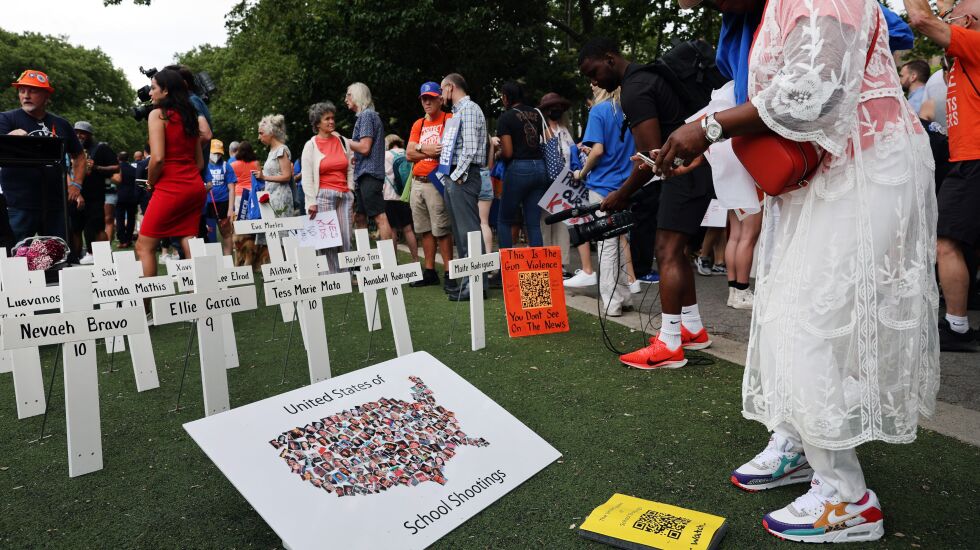
Desperate to find a way to stop the butchering of innocents in America, we tell ourselves this story:
In 1955, upon seeing her son’s mutilated face and body, Mamie Till Bradley made her decision: “Let the people see what they did to my boy.” She told the mortician not to prettify Emmett. She insisted on a glass-topped coffin. She invited a photographer in to take pictures of her beloved son.
Some 100,000 Chicagoans — some say double that number — came to see what the lynchers did to Mamie’s 14-year-old son. The mourners had never met the Tills, never even heard their name before. But they came, gasped, screamed, fainted. And they took new resolve.
All of that is true. But here is the part that is not true.
“Everything changed after the murder of Emmett Till,” CNN reported in 2003, because of the photographs his mother dared the world to see. Time magazine in 2016 placed them among the 100 “most influential images of all time,” because they “forced the world to reckon with the brutality of American racism.”
Former Homeland Security Secretary Jeh Johnson updated the story for today, writing in the Washington Post last week that “photographs of Till’s body, dressed in a suit but with a bloated, mutilated head and face, became an international spectacle, burned into the conscience of anyone who saw them.” Richard Capehart, on the PBS News Hour, agreed, and quoted Johnson. Kara Swisher repeated that potted history in the New York Times.
But that’s not how it happened. That crowd at Emmett’s funeral? They were African American; very few whites attended. The photograph? It appeared first in Jet magazine, then in Black-readership newspapers like the Chicago Defender, but the mainstream media refused to publish it. Few white Americans ever saw Emmett Till’s brutalized face until 30 years later, in 1987, when the Civil Rights documentary “Eyes on the Prize” led with the Till story.
So how could a picture most people never saw spark the 20th century’s greatest mass movement? The key constituency, African Americans, saw it. They cut it out and passed it around, discussed it, got organized, got moving, got in the movement.
Muhammad Ali, roughly Till’s age, wrote in his memoir that the photo changed him. So did the late Rep. John Lewis of Georgia. Author Anne Moody traced her own civil rights activism back to the Till story. Joyce Lardner coined the phrase, “The Emmett Till Generation” for her cohort of young Blacks determined to batter down Jim Crow. They didn’t just profess righteous ideas. They took to the streets. They put their bodies on the line.
When CNN and Time and the rest say that the Till photos started the civil rights movement, they mean that good but quiescent people — whites — were shamed into a new political awareness. Decent citizens finally saw the light, scales fell from their eyes, they rose up, went down to the river and were converted. It is the kind of American story we love to tell, a tale of our own goodness, of can-do progress, of high-mindedness. And we white people feel so righteous about ourselves telling it.
But it didn’t happen that way. White Americans initially never saw that photo, the one that allegedly changed everything. It was the Black activists, the ones who marched, went to jail, got beaten, risked their lives who changed everything.
Publishing grim photographs of mass killings might do some good in reforming America’s insane gun regime. But it won’t be because gun rights fundamentalists see the light. Donald Trump, Ted Cruz, Wayne LaPierre and their ilk cannot be shamed. The National Rifle Association and the gun manufacturers know no gods save money and power.
If shocking photos like those of Emmett Till ever do leak out, and I hope they do, they won’t chasten the NRA or the gun manufacturers or their bought-and-paid-for stooges in the Senate.
But they might motivate those who already know that this can’t go on, that it is wrong and insane, that the killing must stop.
The Emmett Till Generation understood that power must be confronted. Power must be met with numbers, voters, masses who say “no more” to business as usual. Enough already. You can’t shame the shameless, and it isn’t enough just to be right-minded. When we re-learn this hard lesson, then a child and his mother might lead us.
Elliott Gorn teaches history at Loyola University Chicago. He is author of Let the People See: The Story of Emmett Till.
Want to send a letter to the editor or submit an op-ed? Read our guidelines for both.







